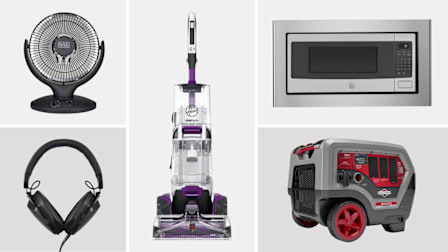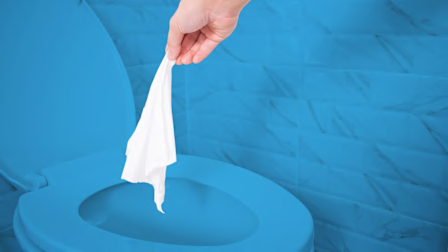Check Your Technique: How to Clean Door Tracks
Clean and lubricate dirty door tracks in seven simple steps
When you shop through retailer links on our site, we may earn affiliate commissions. 100% of the fees we collect are used to support our nonprofit mission. Learn more.

When you sit down to write your spring cleaning checklist, you may not think twice about adding chores like washing bedding, storing comforters, or maybe even deep-cleaning the refrigerator or moving it so that you can finally get into the crevices behind it with a vacuum and mop. After all of your cleaning is done, you may find yourself doing a victory dance and opening up the glass sliding door to let in a little fresh air and the scent of spring—only to discover layers of dirt and gunk stuck between the door tracks.
If you are unsure of how to clean door tracks or have only ever attempted it with a paper towel, your current technique may benefit from expert insight. Once you learn how this no-fuss task can be done in minutes—and how much more pleasant opening and closing the door will be after you’ve mastered it—you won’t look back.
Let’s start with what you shouldn’t do. Even though sliding doors and their tracks straddle the line between outdoors and indoors, it’s a mistake to consider this a cleaning task that Mother Nature will handle.
Inspect, Vacuum, Scrub, and Lubricate
In seven simple steps, you can take door tracks from dirty to spotless and functioning more smoothly. Sabrina Fierman, president of New York’s Little Elves, a professional cleaning company, tells CR she recommends starting with an inspection of the tracks.
Step One: Inspect
Slide the doors from side to side and inspect all of the parts. Check for any loose screws, dents, and misaligned wheels, Fierman says. “If you have any issues, call your door expert or trusted handyman to address [them] to eliminate further damage.”
With a basic inspection of your sliding door complete, it’s time to round up some of the most inexpensive and accessible cleaning supplies and get to work: Grab a bristle brush (more on those below), your vacuum, a bucket of warm water, some dish soap, and several cotton rags.
Step Two: Remove Debris
After you’ve inspected the door and its tracks, remove any obvious debris. Then use a dry bristle brush to loosen any stubborn dust and dried-on dirt. CR home writer Tobie Stanger recommends using a simple old toothbrush to remove debris and scrub dirt away—it’s low-tech but effective.
If you prefer a separate, dedicated tool, there are plenty of cleaning brushes with durable bristles from which to choose. Fierman says she uses a stiff bristle brush with bristles made from plastic natural fibers—no metal bristles—and recommends choosing a brush like the Amazer Scrub Brush with nylon bristles. If, however, the tracks can be easily scratched, Fierman says to use a soft bristle brush instead of a stiff brush.
Step Three: Vacuum
Vacuum the tracks thoroughly using your vacuum’s brush attachment or floor attachment so that you have better control and direction. The right vacuum for you depends on your personal preference and the cleaning jobs you usually tackle. CR found the Shark Ion W1 WV201 a notable handheld vacuum that is portable and can clean up debris in tough spots, though we didn’t test it on door tracks.
Step Four: Prepare for a Scrubbing Session
Now it’s time to prepare to scrub all that dirt and grime off the tracks. Fill a bucket with warm water and a few drops of Ivory Dishwashing Liquid Dish Soap, which Fierman says is a gentle but effective product. For greasy tracks, see step six and determine whether your door tracks may require deeper cleaning.
Step Five: Scrub
Using your brush, scrub the tracks with short back-and-forth motions. Do not apply too much water; it could spill onto the floor and just make more areas dirty. You also don’t want water sitting on any wood flooring you may have adjacent to the door tracks. Using several cotton rags, dry the tracks. The rags may pick up a lot of dirt, so you may want to change these frequently.
Step Six: Decide Whether Deeper Cleaning Is Needed
If your door tracks have just acquired run-of-the-mill dirt, you may be able to stop there, wait for everything to dry, and then jump straight into the lubrication step of maintenance, which is when you’ll apply a silicone lubricant to tracks to ensure that your door slides back and forth with minimal effort.
But if it’s been ages since your sliding door tracks received any love, you should let the tracks dry and assess whether deeper cleaning is needed, Fierman says. If so, sprinkle baking soda onto the tracks. Let it sit while you mix equal parts water and white vinegar in a spray bottle. Spray this blend onto the baking soda and let it sit for a minute or two. Scrub areas that need additional attention and wipe them clean with a cotton rag. This can be repeated as needed until your tracks are spiffy and clean. Make sure they dry thoroughly before moving on to step seven: lubrication.
Step Seven: Lubricate Door Tracks
You’re almost finished. But lubricating door tracks after you clean them is not a step you should skip. “There are several types of sliding doors, and the most common are patio, bi-fold, bypass, and pocket doors,” Galeotafiore says. “It’s important to clean and lubricate the moving parts to make sure they continue to provide smooth operation when opening and closing the door.”
After cleaning door tracks and letting everything dry, Galeotafiore says you can spray a dry silicone spray on the rollers and other moving parts.
Figuring out which product to use to lubricate the tracks opens up an interesting can of worms. CR has not tested lubricants, but Galeotafiore and Fierman recommend using a silicone lubricant on vinyl door tracks.
You might find some tips online saying you should use the legendary lubricant, degreaser, and rust protectant WD-40 to lubricate parts. That may work well at first, but eventually, it attracts dirt and dust and can make the issue worse. Galeotafiore points out that on WD-40’s website, the brand specifically says that its formula does not attract dirt on metal parts.
We reached out to WD-40 to hear its take, and WD-40 brand manager Stepan Harmanlikian noted that the original WD-40 formula, which it calls WD-40 Multi-Use Product, “is great and works well on most things.” However, he added, “in this case, for vinyl door tracks lubrication . . . the WD-40 Specialist Silicone is its most recommended product.”
Whichever silicone-based lubricant you choose, cleaning and lubricating sliding door tracks is one of the easiest cleaning jobs you’re probably forgetting to do—until now.
@consumerreports Storm doors allow you to let in natural light but still keep a buffer between your home and the weather. To find the best, we simulated wind and rain after installing each door in our lab. See the best storm doors of the year through the link in our bio. #hometiktok #hometok #homeimprovement #stormdoors
♬ original sound - Consumer Reports




















